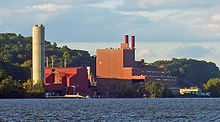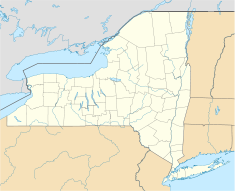- Danskammer Generating Station
-
Danskammer Generating Station 
Danskammer seen from Chelsea across the riverLocation of Danskammer Generating Station Country United States Location Newburgh, NY Coordinates 41°34′22″N 73°57′53″W / 41.57278°N 73.96472°WCoordinates: 41°34′22″N 73°57′53″W / 41.57278°N 73.96472°W Commission date Unit 1 (RFO/gas): Dec, 1951
Unit 2 (RFO/gas): Sep, 1954
Unit 3 (coal/gas): Oct, 1959
Unit 4 (coal/gas): Sep, 1967
Units 5,6 (DFO): Jan, 1967Owner(s) Dynegy Power station information Primary fuel Bituminous coal, residual (RFO) and distillate fuel oil (DFO), natural gas Power generation information Installed capacity 537 MWe (nameplate) Maximum capacity 502 MWe (winter) Danskammer Generating Station is located on the shore of the Hudson River in the Town of Newburgh, New York, United States, 0.5 miles (0.8 km) upstream of the larger oil-fired Roseton Generating Station. Danskammer units 1 and 2 burn oil (72 and 73.5 MWe nameplate capacity), whereas units 3 and 4 are coal-fired (147.1 and 239.4 MWe nameplate capacity). All four of these major units can also run on natural gas.[1] Units 5 and 6 are small internal combustion engines of 2.7 MWe nameplate capacity each. The station was built by Central Hudson Gas & Electric in the 1930s, and sold to Dynegy in the 1990s as part of electricity deregulation. It has been the target of a prolonged environmental lawsuit over its cooling system.
History
The name Danskammer is Dutch for "Dance chamber". On their voyage upriver in 1609 Henry Hudson's crew supposedly saw Native Americans dancing around a fire at the site and thought they were looking at "the Devil's dance chamber". There was once a lighthouse, Danskammer Point Light, at the site.[2]
In 2001 Central Hudson sold both Roseton and Danskammer to Dynegy, under new rules deregulating electricity, in order to become just a distributor of power.[3] Dynegy later added a facility that allowed the plant, which had previously received coal only by rail, to receive coal from self-unloading ships.[4]
Shortly afterwards, environmental activists began to raise concerns about the plant's emissions. According to Environmental Protection Agency figures, it was among the top ten releasers of pollutants by weight in New York, releasing 1.4 million pounds (560,000 kg) of hazardous emissions in 2000.[5] Dynegy defended its operation of the plant as entirely within its permits.[5]
The environmental group Riverkeeper took note of the long-overdue renewal of the plant's discharge permit from the state Department of Environmental Conservation (DEC). In common with Roseton and Indian Point Energy Center, its use of once-through cooling, in which river water was pumped in, used to cool the plant, then pumped out warm, dated to the 1950s and was responsible for large fish kills in the river. A state judge had voided the permit,[6] but it was reversed on appeal.[7] After DEC rebuffed Riverkeeper's effort to force it to accelerate the process,[8] and ruled that closed-cycle cooling, the environmental group's preferred alternative, was not feasible at Danskammer, Riverkeeper filed suit against DEC and Dynegy alleging violations of state administrative-procedure law in issuing the new permit.[9] They alleged that DEC had accepted Dynegy's argument that it didn't have space to install closed-cycle cooling despite the company owning large tracts of adjacent vacant land, and that it had allowed Dynegy to account for its water withdrawals in an unrealistic fashion.[10] Dynegy says there are cheaper alternatives to the cooling towers a closed-cycle system would require.[11]
During the late 2000s, Dynegy filed a suit of its own. It alleged that the plants had been overvalued and thus that it had paid more in taxes to Orange County, the Town of Newburgh and the Marlboro school district than it should have. The exact reasons for the alleged overvaluation remained confidential as a result of a judge's gag order in the case in order to protect Dynegy's proprietary information regarding the plant. It was later settled, resulting in an increase in local property taxes, particularly in the school district.[12]
References
- ^ "Existing Electric Generating Units in the United States, 2008" (Excel). Energy Information Administration, U.S. Department of Energy. 2008. http://www.eia.doe.gov/cneaf/electricity/page/capacity/capacity.html. Retrieved 2009-11-28.
- ^ Mumford, Warren (May 17, 2007). "History: Danskammer Point Light". Village of Cornwall on Hudson. http://www.cornwall-on-hudson.com/article.cfm?page=718. Retrieved November 21, 2007.
- ^ "Central Hudson Closes Sale on Roseton and Danskammer Generating Plants; Divestiture Means Immediate Changes in Customer Bills" (Press release). Business Wire. January 30, 2001. http://findarticles.com/p/articles/mi_m0EIN/is_2001_Jan_30/ai_69710760/. Retrieved November 21, 2009.
- ^ McCartney, Richard (October 15, 2006). "Designing and upgrading plants to blend coal". Tradefair Group. http://powermag.com/coal/Designing-and-upgrading-plants-to-blend-coal_577_p4.html. Retrieved November 21, 2009. "Danskammer Generating Station. This plant in Roseton, N.Y., used to receive all of its coal by unit trains. A self-unloading coal-receiving system capable of handling ships as heavy as 30,000 dwt (deadweight tons) was added to enable deliveries of coal from the Hudson River"
- ^ a b Hall, Wayne (July 11, 2002). "Newburgh plant one of N.Y.'s top 10 polluters". Ottaway Community Newspapers. http://archive.recordonline.com/archive/2002/07/11/whairqua.htm. Retrieved November 21, 2009.
- ^ "Danskammer permit voided". Associated Press. October 1, 2004. http://archive.recordonline.com/archive/2004/10/01/hudsonri.htm. Retrieved November 21, 2009.
- ^ "Environmentalists fail in suit vs. Danskammer". Times-Herald Record (Ottaway Community Newspapers). April 21, 2006. http://archive.recordonline.com/archive/2006/04/21/brf299.htm. Retrieved November 21, 2009.
- ^ Crotty, Erin (October 1, 2002). "Danskammer Electric Generating Plant - Commissioner's Ruling, October 1, 2002". New York State Department of Environmental Conservation. http://www.dec.ny.gov/hearings/11166.html. Retrieved November 21, 2009.
- ^ Bruno, Greg (July 27, 2006). "Suit questions Danskammer's cooling system". Times-Herald Record (Ottaway Community Newspapers). http://www.recordonline.com/apps/pbcs.dll/article?AID=/20060727/NEWS/607270326/-1/BIZ01. Retrieved November 21, 2009.
- ^ Reiss, Warren (November 11, 2007). "Cool it on the Hudson". The New York Times (The New York Times Company). http://www.nytimes.com/2007/11/11/opinion/nyregionopinions/11WEreiss.html. Retrieved November 21, 2009.
- ^ Bruno, Greg (August 3, 2006). "Dynegy power plant vs. Hudson River life". Times-Herald Record (Ottaway Community Newspapers). http://www.recordonline.com/apps/pbcs.dll/article?AID=/20060803/NEWS/608030331. Retrieved November 21, 2009.
- ^ Ross, Carrie (November 13, 2008). "Hitting the ceiling". Woodstock Times (Ulster Publishing). http://www.ulsterpublishing.com/index.cfm?fuseaction=article&articleID=471060. Retrieved November 21, 2009. "The question: What could be done about the steep increase in school taxes in the aftermath of the $40 million Dynegy settlement and a $20 million dollar high school building bond, causing school taxes to skyrocket more than 40 percent for many this year."
Categories:- Energy resource facilities in New York
- Hudson River
- 1930s establishments
- Newburgh, New York
- Environment of New York
- Coal-fired power stations in New York
- Oil-fired power stations in New York
- Natural gas-fired power stations in New York
Wikimedia Foundation. 2010.

